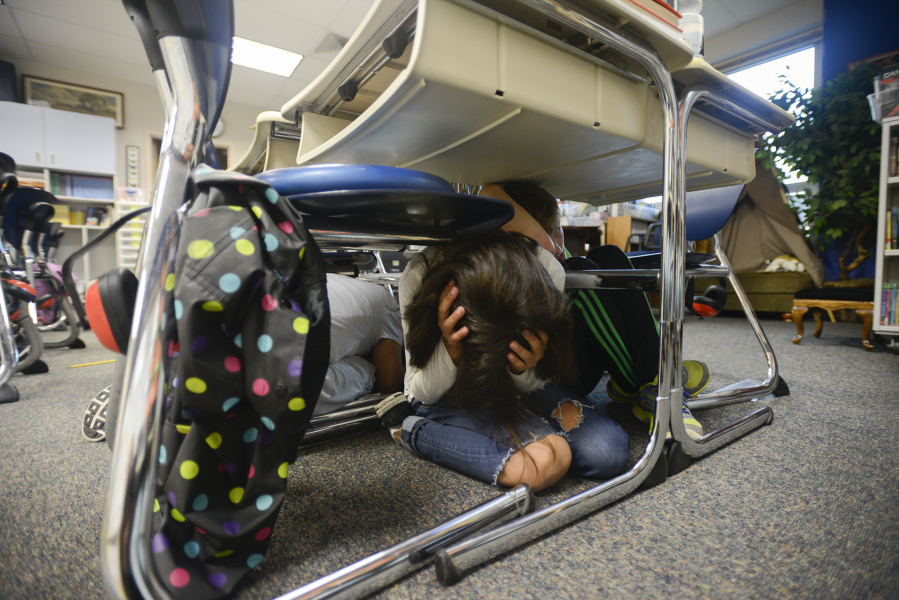CAMAS — An announcement came over the Prune Hill Elementary School’s public address system and the fourth-graders in Julie Menor’s class stopped their work Thursday: For an earthquake.
Things went exactly as planned and practiced. The students tucked themselves under their desks and chairs and kept their heads covered.
It was a drill, of course. During the real thing, it’d likely be fairly clear what was happening without a PA announcement.
The kids and staff at Prune Hill joined more than a million others around Washington, and millions more worldwide, in the drill, called the ShakeOut.
Almost 37,000 people said they were planning on participating in earthquake exercise in Clark County.
“I think we’ve gotten a little more publicity on it in the last couple of years,” said Eric Frank, emergency management coordinator with the Clark Regional Emergency Services Agency (CRESA).
Frank said CRESA planned some drills, as did several departments with the county and city of Vancouver. Multiple schools joined in as well.
Participation in Washington’s ShakeOut has definitely increased with renewed interest in the Cascadia Subduction Zone, a fault line running along the coast that’s the source of regular, powerful quakes, he said.
Maximilian Dixon, the earthquake program manager at the Washington Military Department’s emergency management division, said the state has been expanding outreach into the Spanish-speaking community and through social media.
“We’re trying to build muscle memory in people so they can react as quickly as possible during an earthquake,” he said.
Prune Hill’s Menor said staff spoke with students about the drill over the past few days.
“They start with lots of ‘what-ifs,’ so it leads to lots of discussions,” she said.
The school’s principal, Julie Swan, said the school does multiple drills throughout the year, but most are evacuations, like for a fire drill.
Last year, they simulated an evacuation and reunification at another site — complete with a few embedded organizational errors and frantic parents
The drills help identify possible kinks in the process and help everyone prepare mentally, if only a little, she said.
“The more times we do it, the less anxious you are.”
There are thousands of earthquakes in the region every year, Dixon said, but most people never notice them, so how to respond to a bad one might not come to mind quickly when it counts.
The Pacific Northwest Seismic Network has tracked 90 earthquakes in the Northwest over the past two weeks. The largest was a magnitude 4.8 tremor many miles off the Oregon coast. A 1.1 magnitude earthquake was reported in Gresham, Ore., on Oct. 8, and a 0.7 quake was noticed north of Yale Monday.
“So this our one really big deal we can do so people will drop, cover and hold on,” Dixon said.
In June, emergency managers in Oregon and Washington held a multi-agency drill, dubbed Cascadia Rising, to practice responses for the expected catastrophic earthquake geologists say will inevitably hit the region.
Movement in an 800-mile long fault along the coast of the Northwest causes a magnitude 8.0 to 9.0 earthquake about every 200 to 500 years, and the last major earthquake and tsunami along the fault occurred more than 300 years ago.
Disaster response planners and emergency workers took away multiple lessons from the exercise, Dixon said, but the big lesson they hope to pass to everyday people is to stock up for the long haul.
The state now recommends everyone has at least two weeks of food and water ready in case of a serious emergency.
“The ability for us to respond at the state and federal level is really going to take a long time,” Dixon said. “A lot longer than I think people imagine.”
Should such a quake hit, the coast will take the brunt of the damage from the shaking and accompanying tsunami, but much of the west side of the Cascades will see heavy damage to buildings and infrastructure.
Other recommendations haven’t changed, Dixon said: Things like having a supply kit, a communications plan, and someone to contact elsewhere.
He added emergency managers are bracing for a quake that would likely be the greatest natural disaster in American history
“We’re planning for the worst-case scenario. But really, if you have two weeks of food, water and supplies, you’re going to be prepared for just about anything,” he said, from bad storms, to flooding to other events.
Thursday’s drill lasted just few minutes. Menor’s students gathered around and talked about it after.
They students all said they hoped the intercom announcement would include some sound effects, but they agreed they had time to huddle under their desks and protect their head.
They’ve been talking about it to get ready for a while now, and Jett Budzik said he expected everything to go as planned.
“We would hide under our desks and be OK,” he said.




